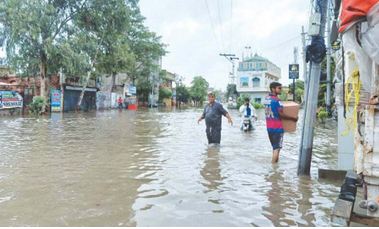Gujrat, a city in Punjab, Pakistan, and its surrounding areas are grappling with an unprecedented flooding disaster, the likes of which have not been witnessed in recent memory. The floodwaters have not only inundated residential areas, but have also caused widespread displacement and destruction. What makes this crisis particularly alarming is that it is not solely a natural phenomenon, but a man-made one—a direct result of years of negligence, poor urban planning, and a blatant disregard for natural ecosystems.
The core of the problem lies in the fact that the floodwater has no natural exit. Gujrat and its adjoining areas are historically known for their intricate network of water channels and natural depressions that would typically absorb or redirect excess water. However, in a relentless pursuit of urban expansion, these vital water reservoirs have been encroached upon and, in many cases, completely occupied by sprawling housing societies. This rapid, unregulated construction has effectively choked off the natural drainage system, leaving the water with nowhere to go. The very ground that once served as a sponge, allowing water to percolate and replenish the groundwater table, is now covered in concrete, leading to a disastrous runoff.
The floodwater, in this case, has not originated from a single major river, but from the surrounding smaller water bodies and rainwater that, under normal circumstances, would have been absorbed or drained away. The relentless rains in the region have only exacerbated the situation, turning the city into a giant basin with no outlet. The water, instead of flowing, has stagnated, creating a quagmire that poses a serious threat to public health and infrastructure.
Another major contributing factor to this disaster is the Sialkot-Islamabad Motorway. While motorways are crucial for economic development and connectivity, their construction must be meticulously planned to account for the natural environment. In the case of the Sialkot-Islamabad Motorway, it appears that the natural waterways and flow patterns were largely ignored. The construction of the motorway has blocked and diverted the traditional paths of water, forcing it to inundate villages and low-lying areas that were previously safe. The poor planning and execution of this project have turned a vital piece of infrastructure into a barrier, trapping water and leading to widespread flooding.
The disaster in Gujrat serves as a stark reminder of the consequences of reckless development. The city’s authorities and planners failed to foresee the long-term impact of their actions. They did not factor in the critical role of natural drainage systems or the importance of respecting the flow of water. This is a classic case of short-sighted progress leading to long-term suffering.
Moving forward, it is imperative that the government and urban planners learn from this catastrophe. A comprehensive review of all development projects, particularly those that interfere with natural water bodies, is urgently needed. There must be a shift towards sustainable and eco-friendly urban planning that respects nature, rather than conquering it. The homes and villages of the people of Gujrat can be rebuilt, but the trust in a system that failed to protect them will be much harder to restore.

















